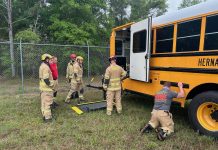Children will drown if their school buses submerge in a body of water. They won’t have time to evacuate during a school bus fire. They will be forced off the school bus and into a less safe ride to and from school because of decreased passenger capacity. On average one student’s life will be saved a year while costs of new school buses skyrocket.

These are all familiar and potential unintended consequences of lap-shoulder seat belts often cited by student transporters. Yes, new school buses equipped with the occupant restraints cost about $5,000 to $10,000 more, but the reduced capacity argument has largely fallen by the wayside thanks to three-two seating configurations on modern school bus seats. Meanwhile, and thankfully, most districts that have incorporated lap-shoulder belts into their operation have not experienced a serious crash, so there is little hard data on how the systems protect students. But some anecdotal reports to STN indicate they work well, and the video from the Anaheim, California crash a few years ago shows they saved at least one life.
Still the arguments against remain. As one director told me recently, you can “what-if” the issue forever. He is one of a growing number of industry professionals—especially school bus drivers, themselves—who say they want no other school bus than one equipped with the occupant restraints.
What else do they know that the others don’t?
Two years ago, barely 14 percent of readers responding to our annual directors and supervisors survey said their school districts were requiring three-point, lap-shoulder seat belts. Fast forward to today, and that figure has more than doubled to over 31 percent.
A statistic from this month’s survey that leaps from the page is one that shows school districts are increasingly choosing to implement three-point seat belts, despite no state law requiring them to do so. In fact, half of 50 school districts who said they now use lap-shoulder belts are doing so voluntarily.
That’s a change for this industry. But why?
It was two years ago this month that NHTSA Administrator Mark Rosekind suggested—and stopped short of requiring—that all large school buses should have lap-shoulder belts as the best way to prevent student injuries and deaths in crashes. Subsequent meetings between NHTSA, the student transportation industry and safety officials uncovered a different and markedly better unintended consequence. Aside from the safety benefits three-point seat belts provide in side-impact and rollover crashes, essentially completing compartmentalization, school bus drivers said that lap-shoulder belts are reducing on-board student behavior issues and resulting driver distraction.
NHTSA responded by proposing a three-point seat belt study that would include a survey of school bus drivers to gauge their real-world experiences. The industry hopes to receive an update this month at the NASDPTS Annual Conference. But we wanted to provide added insight this month, so I spoke with several districts who voluntarily added lap-shoulder seat belts and those who drive the routes. You can read their perspectives starting on page 46 of our November issue.
We saw Texas strengthen its three-point seat belt law and Nevada add its own requirement for 2019, but why haven’t we seen more states jump on the bandwagon despite this driver feedback plus the ongoing legislative debate that was only fueled by Rosekind’s 2015 recommendation. Local school districts are taking matters into their own hands, which was NHTSA’s original intent when only requiring lap-shoulder belts for Type A school buses a decade ago.
“There is difficulty with a law, but we will continue to see districts drive a requirement despite budgetary issues,” explained Michael LaRocco, the state director of transportation for the Indiana Department of Education. He made his comments during an Aug. 21 roundtable discussion held by school bus seating and seat-belt manufacturer IMMI, following a crash test held at the company’s Center for Advanced Product Evaluation.
It seems some school districts are learning that they can put a dollar amount on safety as well as help school bus drivers do their job better with at least a little less stress, which could affect the current shortage. They saying goes that you must spend money to make money. But as some student transporters are also learning via technology, lap-shoulder belts could save money, too.
Reprinted from the November 2017 issue of School Transportation News magazine.
















